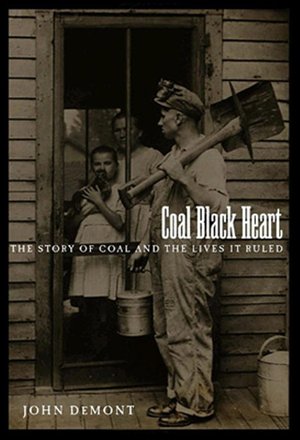Coal Black Heart:
The Story of Coal and the Lives it Ruled

Support Canada's History in other ways (more)
by John DeMont
Doubleday Canada, Toronto, 2009
352 pp., illus., $34.95 hardcover
One such metaphorical journey is John DeMont’s Coal Black Heart, a hybrid sort of history of coal mining in Cape Breton, primarily in the twentieth century. DeMont’s epiphany apparently came when Maclean’s magazine sent him to cover the Westray disaster in the spring of 1992. There, twenty-six men were lost in Nova Scotia’s last major mining tragedy, and DeMont encountered the results of unshackled capitalism: executives developing and mismanaging a coal mine as if it were in some underdeveloped part of the world, where its managers had been used to operating. Setting off to uncover the background to that story, he undertook a decade-long odyssey to find out how coal mining came to Nova Scotia and to explore his own roots within that story.
DeMont has written widely for magazines and is well-known for his group biography of the Irving family as well as a feel-good book on Nova Scotia. He is descended from families that worked Cape Breton’s coal for much of the century, though it is obvious from the tone of this book that he never directly experienced life in a coal community. We end up with a somewhat vicarious account of the trials and tribulations of coal miners. While DeMont’s book draws heavily on the scholarship of the past few decades, it is interwoven with his own family’s history of involvement with coal mining.
He comes to this story as a committed and skilled writer, rather than as a scholar. His gloss on the scholarly research is sometimes choppy and poorly integrated, and his interweaving of family history sometimes seems forced, perhaps reflecting a compulsion to identify with the experiences of the coal miners he seems to idolize. He conducted some very effective interviews with retired miners and local notables, and these are used to good effect from time to time.
But in the end, DeMont’s command of the hundred years of the rise and fall of the coal industry of Cape Breton is mostly that of someone who is an outsider to the heavy slogging of historical research. It shows more often than it should. Yet he never claims to be a historian. To his credit, DeMont summarizes the relevant scholarship effectively enough to contextualize and embellish his own story.
We end up with a heroic, hardscrabble sort of self-reflexive narrative, which essentializes the miners’ experience as victims of unfettered capitalism, but without really expanding our understanding of their experiences. Miners are clearly the story’s heroes, but we actually read very little about their intimate lives; and the book includes little of the work experience of his ancestors, something that might have helped push the narrative along.
The most direct “experience stories” come from scientists and engineers, along with the officials who directed much of the industry. DeMont’s own forebears’ migrations to Cape Breton at the turn of the twentieth century are well told, albeit somewhat imaginatively.
John DeMont has sketched out a popular account of the last hundred years of coal mine development. But it is a disjointed story, well written in parts, but seldom insightful. For the real story, interested readers would do well to look at the work of the scholars DeMont cites so often, particularly the award-winning biography of James B. McLachlan by David Frank, or works by Dan Samson or Don MacGillivray. Or, better still, readers might visit one of the half-dozen historic sites and museums dedicated to the industry across Nova Scotia.
— Del Muise (Read bio)
Del Muise taught Atlantic Canadian History at Carleton University for the past forty years and is a native of New Waterford, in the heart of Cape Breton's coalfields.